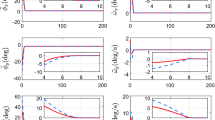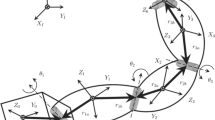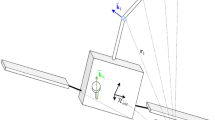Abstract
This paper tackles the problem of integrated translation and rotation stabilization of the spacecraft in proximity operations by proposing a novel manipulator actuation strategy. To do so, by theoretically integrating the attitude/position motion of the spacecraft and the joint motion of the manipulator, a coupled translational and rotational kinematics of the spacecraft with a single space manipulator mounted is formulated, where system unknown parameters and residual system momentum are taken into account and analyzed. Taking the joint motion as the control input, a projection-based adaptive control scheme is then developed such that the translation and rotation of the spacecraft can be robustly stabilized with the manipulator-based actuation. The closed-loop asymptotic stability is guaranteed within Lyapunov framework. Meanwhile, considering the constrained joint motion of the manipulator, the resulting control constraint issue is handled by developing an optimization based bound analysis method, which also facilitates the determination of control parameters. Two scenario numerical simulations demonstrate the effect of the designed control scheme.
Similar content being viewed by others
References
F. Terui, “Position and attitude control of a spacecraft by sliding mode control,” Proceedings of American Control Conference, Philadelphia, Pennsylvaia, USA, pp. 217–221, June 1998.
R. Kristiansen, P. J. Nicklasson, and J. T. Gravdahl, “Spacecraft coordination control in 6DOF: integrator backstepping vs passivity-based control,” Automatica, vol. 44, no. 11, pp. 2896–2901, 2008.
M. Xin and H. Pan, “Integrated nonlinear optimal control of spacecraft in proximity operations,” International Journal of Control, vol. 83, no. 2, pp. 347–363, 2010.
J. Wang, H. Liang, Z. Sun, S. Zhang, and M. Liu, “Finite-time control for spacecraft formation with dual-number-based despcription,” Journal of Guidance, Control and Dynamics, vol. 35, no. 3, pp. 950–962, 2012.
R. Xu, H. Ji, K. Li, K. Yu, and K. Yang, “Relative position and attitude coupled control with finite-time convergence for spacecraft rendezvous and docking,” Proceedings of IEEE Conference on Decision and Control, Osaka, Japan, 2015.
D. Lee and G. Vukovich, “Almost global finite-time stabilization of spacecraft formation flying with decentralized collision avoidance,” International Journal of Control, Automation, and Systems, vol. 15, no. 3, pp.1167–1180, 2017.
H. Min, S. Wang, and F. Sun, “Distributed six degree-offreedom spacecraft formation control with possible switching topology,” IET Control Theory and Applications, vol. 5, no. 9, pp. 1120–1130, 2011.
L. Sun and W. Huo, “6-DOF integrated adaptive backstepping control for spacecraft proximity operations,” IEEE Transactions on Aerospace and Electronic Systems, vol. 51, no. 3, pp. 2433–2443, 2015.
L. Sun and W. Huo, “Robust adaptive backstepping control for autonomous spacecraft proximity maneuvers,” International Journal of Control, Automation, and Systems, vol. 14, no. 3, pp.753–762, 2016.
L. Sun, W. Huo, and Z. Jiao, “Adaptive backstepping control of spacecraft rendezvous and proximity operations with input saturation and full-state constraint,” IEEE Transactions on Industrial Electronics, vol. 64, no.1, pp. 480–492, 2017.
H. Gui and G. Vukovich, “Finite-time output-feedback position and attitude tracking of a rigid body,” Automatica, vol. 74, pp. 270–278, 2016.
F. Curti, M. Romano, and R. Bevilacqua, “Lyapunov-based thrusters’ selection for spacecraft control: analysis and experimentation,” Journal of Guidance, Control, and Dynamics, vol. 33, no. 4, pp. 1143–1160, 2010.
F. Zhang and G. R. Duan, “Integrated translational and rotational finite-time maneuver of a rigid spacecraft with actuator misalignment,” IET Control Theory and Applications, vol. 6, no. 9, pp. 1192–1204, 2012.
F. Zhang and G. R. Duan, “Robust adaptive integrated translation and rotation control of a rigid spacecraft with control saturation and actuator misalignment,” Acta Astronautica, vol. 86, pp. 167–187, 2013.
F. Zhang and G. R. Duan, “Robust adaptive integretd translation and rotation finite-time control of a rigid spacecraft with actuator misalignment and unknown mass property,” International Journal of Systems Science, vol. 45, no. 5, pp. 1007–1034, 2014.
B. Bill, “A combined earth scanner and momentum wheel for attitude determination and control of small spacecraft,” Proceddings of the 26th Aerospace Mechanisms Symposium, Maryland, USA, 1992.
T. Tsuji and K. Ohnishi, “Mechanism of attitude control device for floating oject,” Proceedings of 2003 International Conference on Industrial Technology, Maribor, Slovenia, 2003.
J. Shen and N. McClamoroch, “Translational and rotational maneuvers of an underactuated space robot using prismatic actuators,” International Journal of Robotics Research, vol. 21, no. 5–6, pp. 607–618, 2002.
H. Wang and Y. Xie, “Prediction error based adaptive Jacobian tracking for free-floating space manipulators,” IEEE Transactions on Aerospace and Electronic Systems, vol. 48, no. 4, pp. 3207–3221, 2012.
K. Yoshida, “Engineering test satellite VII flight experiments for space robot dynamics and control: theories on laboratory test beds ten years ago, now in orbit,” The International Journal of Robotics Research, vol. 22, no. 5, pp. 321–335, 2003.
M. Wang, J. Luo, and W. Ulrich, “Novel synthesis method for minimizing attitude disturbance of the free-floating space robots,” Journal of Guidance, Control and Dynamics, vol. 39, no. 3, pp. 693–702, 2016.
S. Xu, H. Wang, D. Zhang, and B. Yang, “Adaptive zero reaction motion control for free-floating space manipulators,” IEEE Transactions on Aerospace and Electronic Systems, vol. 52, pp. 1067–1076, 2016.
W. C. Sun, S. Tang, H. J. Gao, and J. Zhao, “Two timescale tracking control of nonholonomic wheeled mobile robots,” IEEE Transactions on Control Systems Technology, vol. 24, no. 6, pp. 2059–2069, 2016.
W. C. Sun, Y. Zhang, Y. Huang, H. J. Gao, and C. Kaynak, “Transient-performance-guaranteed robust adaptive control and its application to precision motion control systems,” IEEE Transactions on Industrial Electronics, vol. 63, no, 10, pp. 6510–6518, 2016.
X. Liu, W. Jiang, and X. C. Dong, “Nonlinear adaptive control for dynamic and dead-zone uncertainties in robotic systems,” International Journal of Control, Automation, and Systems, vol. 15, no. 2, pp. 875–882, 2017.
Y. Xu and T. Kanade, Space Robotics: Dynamics and Control, Kluwer Academic Publishers, Boston, 1992.
B. Yao and M. Tomizuka, “Adaptive robust control of MIMO nonlinear systems in semi-stric feedback form,” Automatica, vol. 37, pp. 1305–1321, 2001.
H. K. Khalil, Nonlinear Systems, 3rd edition, Prentice-Hall, New Jersey, 2002.
K. J. Astrom and B. Wittenmark, Adaptive Control, 2nd edition, Addison-Wesley Publishing Company Inc, New York, 1995.
Author information
Authors and Affiliations
Corresponding author
Additional information
Recommended by Associate Editor Andrea Cristofaro under the direction of Editor Myo Taeg Lim. This work is supported by the National Natural Science Foundation of China under grant 61703437.
Feng Zhang received his Ph.D. degree in control science and engineering in 2013 from Harbin Institute of Technology, China. He is currently a senior engineer in Research and Development Center at China Academy of Launch Vehicle Technology. His research interests include spacecraft guidance and control, and nonlinear control.
Guang-Ren Duan received his Ph. D. degree in control systems theory in 1989 from Harbin Institute of Technology, China. He is currently the director of the Center for Control Theory and Guidance Technology at Harbin Institute of Technology. He is a chartered engineer in the UK, a fellow of IEEE and a fellow of IEE. His research interests include robust control, missile autopilot design, and spacecraft control.
Rights and permissions
About this article
Cite this article
Zhang, F., Duan, GR. Manipulator-actuated Adaptive Integrated Translational and Rotational Stabilization for Spacecraft in Proximity Operations with Control Constraint. Int. J. Control Autom. Syst. 16, 2103–2113 (2018). https://doi.org/10.1007/s12555-017-0689-7
Received:
Revised:
Accepted:
Published:
Issue Date:
DOI: https://doi.org/10.1007/s12555-017-0689-7




